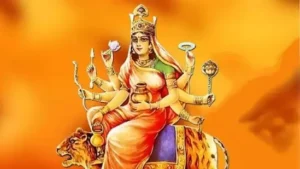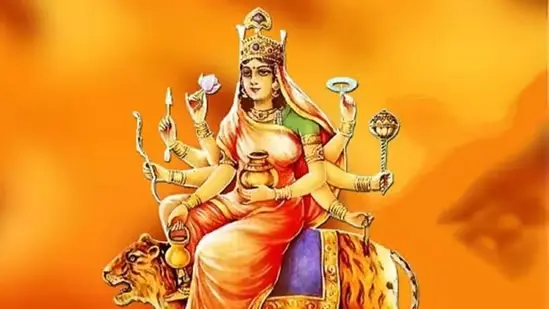Navratri Day 4: On October 18, which is the fourth day of Navratri, we commemorate the adoration of Maa Kushmanda. It is crucial to understand the significance, puja ceremonies, scheduling, offerings, and other aspects of this day.

On Wednesday, October 18, 2023, is the fourth day of Navratri. Goddess Durga and her nine forms, known as the Navadurgas, are the focus of this nine-day festival. Maa Siddhidatri, Maa Shailputri, Maa Brahmacharini, Maa Chandraghanta, Maa Kushmanda, Maa Skandamata, Maa Katyayani, Maa Kalratri, and Maa Brahmacharini are a few of them. People fast, eat sattvic meals, pray to Goddess Durga in her many guises, and seek the favor of the gods during this Hindu holiday. Devotees offer Maa Kushmanda puja on the fourth day. Understanding Maa Kushmanda’s significance and learning about the fourth day of Sharad Navratri’s importance, puja procedures, time, offerings, and other details are essential if you and your family are participating in the festival.
Who is Maa Kushmanda and what does Navratri 2023 Day 4 mean?
Three words make up the name Maa Kushmanda: “Ku” for little, “Ushma” for warmth, and “Anda” for cosmic egg. Hindu mythology claims that the universe was born from a single glance at Maa Kushmanda’s smile. Her right hands are occupied by a kamandal, a bow, an arrow, a lotus, a rosary, a club, and a discus, while her left hands are occupied by a container of nectar, a rosary, a gada (mace), and a chakra (wheel). She is also referred to as the Goddess with eight arms. She controls the sun’s direction and energy, and her luminosity and aura are similar to the sun’s brilliance. Lord Surya, the sun deity, is hence under Goddess Kushmanda’s control.
Maa Kushmanda is frequently seen riding a tiger, representing her bravery and fortitude. She is renowned for bestowing money, health, and strength upon her followers. Her puja is performed by devotees on the fourth day of Navratri. If you and your family are celebrating the holiday, it is crucial to grasp Maa Kushmanda’s significance. Continue reading to discover more about the fourth day of Sharad Navratri’s significance, puja procedures, scheduling, offerings, and other details.
Navratri Day 4 Puja Rituals, Offerings, Colors, and Timing:The Drik Panchang predicts that this year’s Sharad Navratri Chaturthi Tithi will occur on October 18. The Chaturthi Tithi lasts from 1:15 PM to 10:58 AM on the same day. The Vijay Muhurta for this day is from 2:00 PM to 2:46 PM, and the Brahma Muhurta is from 4:43 AM to 5:33 AM. On this day, there are no Abhijit Muhurta.
The Navratri Day 4 is related with the color blue, which stands for peace and prosperity. Devotees are encouraged to present red flowers during the puja since Maa Kushmanda enjoys them. You can give her ornaments like sindoor, kajal, bangles, bindis, anklets, hairpins, mirrors, and payals in addition to flowers. Prepare a special bhog of yogurt, malpua, and halwa to present to the Goddess as well.





